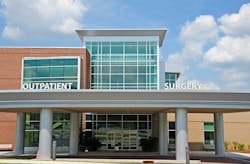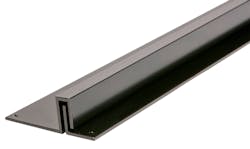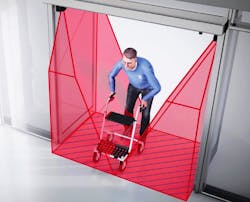With respect to healthcare security, there’s no one-size-fits-all strategy. Solutions applicable at massive hospital complexes can be overkill at a small office.
According to IBISWorld, more than 440,000 small healthcare facilities exist in North America. You often find offices clustered in small medical plazas or close to larger hospitals. These businesses include 190,000 dental offices, 140,000 primary-care doctor offices, 25,000 medical diagnostic labs, 10,000 diagnostic imaging centers and 10,000 urgent-care facilities, among others.
The bottom line is that, on average, there are 16 small healthcare facilities for every locksmith. This article explores the market for small healthcare facilities, what to look for, effective sales strategies and product resources.
Foot in the Door
In many cases, your first contact will be a routine service call. In others, an office manager might call to ask for recommendations on security upgrades. They might even ask how much it would cost to install electronic access control (EAC). To move forward, you have to do three things:
- Look and act like a security pro.
- Focus on the customer’s concerns and agenda.
- Know what to look for and what questions to ask.
As we walked through several small and medium-size medical facilities, we found many common issues. These range from standard hinge, closer and lock operation to higher levels of defeat resistance or accountability. By asking the right questions, you often uncover unknown customer wants that lead to profitable business, but trying to sell something is a mistake.
Customer motivations can vary greatly. Many will be focused on low cost, while others will have serious security or regulatory concerns. In some cases, high-end offices will want to present a more sophisticated image.
We often see quality furnishings and appointments in cosmetic surgery and orthodontics offices that cater to a more affluent clientele. These facilities will be particularly aware of their image and are more likely to consider high-end electronic upgrades, even biometrics, such as the HID Lumidigm multi-spectral fingerprint reader, or an iris or vein scan device. Most offices, however, will focus on budget solutions.
Whatever the case, your job is to respond professionally to the client’s service demands. During a service call, ask whether there are any other concerns or door hardware items that require attention while you’re there. You’ll profit far more in the long run if the customer understands you’re there to save them money.
Checkpoints
Following are some of the areas that might require attention.
If sophisticated external attacks are likely, upgraded pick and tamper resistance can be suggested for external deadbolts. However, the overwhelming majority of key-control problems come from within. Keys are lost, loaned, stolen or not returned. A properly explained key policy and signed key agreement are effective and cost the owner nothing.
Treatment or work areas: These are likely the most important concerns. The door from the patient waiting area must remain locked from the waiting-room side at all times and is a prime EAC candidate. (See “The Switch Is On.”)
This critical interior door defends against hostile attacks or disruption of the treatment, test or work areas. The Department of Health and Human Services in December 2022 issued a notice of dramatically increased workplace violence in medical facilities, so this might be the most critical security issue of all.
Use only storeroom F86 cylindrical, F07 mortise locks or exit devices that have entrance only by key or electronic release. Push- or turn-button locks are left unlocked too easily. Electrified locks or exit devices provide a clean, low-profile appearance. In many cases, an electrified lock or strike is operated from the reception desk.
Records: All medical providers must comply with the Healthcare Insurance Portability and Accountability Act (HIPAA) regulations that require protection of patient medical data. The computer server and records storage rooms are prime electronic upgrade candidates.
Diagnostic and test equipment: This valuable equipment always has to be restricted. At a recent MRI exam, I was ushered past two locked doors and into a third locked room where the procedure was performed. Each door was secured by using EAC. Free egress from each area was granted by BEA touchless actuators. These wave-to-open switches add a lot of sizzle to a facility at rather low cost.
Lab equipment: Blood test areas, sterile zones, biohazard and medical supply storage are areas that might benefit from electronic upgrades.
Most emergency vehicles have locked cabinets, but even patented keys can be lost or stolen. This is likely to be an urgent issue for all emergency vehicles.
Patient medications are controlled in a locked room or cabinet. EAC accountability is necessary, but until recently, cost has been an obstacle.
Low-energy door operators are common in exterior doors at nursing facilities but are frequently held open for too long. The delay allows extreme cold or hot weather to overwhelm the HVAC system. Extended opening time can waste thousands of dollars in excess energy costs each year.
BEA laser-based time-of-flight sensors are typical of sensors that detect the presence of people in a door path, holding a door open only as long as necessary. dormakaba, LCN, Norton and others have similar products.
Group homes: These are a budget-conscious market that has seen explosive growth. The homes typically are regular neighborhood residences that serve 6–8 patients. These facilities charge patients half the rate of larger skilled-nursing sites and typically have a nurse on duty part time.
Electronic cabinet and drawer locks might be a good solution in many cases. The BEST cabinet lock with Switch Core and Olympus Lock’s SALTO cabinet lock adaptation are examples of a new breed of inexpensive cabinet lock applications. The CompX StealthLock is another interesting product. The lock hides inside a cabinet, with an external keypad that controls 1–4 doors.
Other electronic cabinet locks include BEA and HES maglocks, plus dormakaba, HES, and Schlage cabinet locks.
Finally, to move to the next level of customer trust, you have to look as though you belong. In my first security job, I was coached to dress for the position I wanted, rather than looking cool for my buddies. It paid off beyond my wildest dreams. Technicians who look sloppy or brag about their black-bag skills won’t be asked to survey more-sensitive areas of a healthcare facility. If you want to be viewed as a security pro, you have to look, dress and act like it. I can tell you from experience that it pays off.
Cameron Sharpe, CPP, worked 30 years in the commercial lock and PACS industry. [email protected]
The Switch Is On
Electronic access control (EAC) can have a lot of hidden costs. Typically, you’ll have the electrified lock, strike or maglock, the reader, a connecting panel, a power supply, some means of communication, a head-end control unit and some wiring. Your competitive edge is to provide more security at less cost.
BEST’s Switch Core can reduce EAC costs dramatically. This low-cost electronic core plugs into nearly any existing physical-security system and is operated by a mobile app.
LOCKT has taken this a step farther, allowing a lockshop to install a Switch Core system where no infrastructure or head-end controller exists. Here’s how the LOCKT program works:
1. Log onto your assigned URL. This is your complete PACS head end.
2. Configure doors, users, schedules, etc.
3. Download the Switch Tech app
4. Install the Switch Cores (about 1-minute each).
5. Show users how to use the app.
However, as of this writing, there are a few drawbacks. Switch Core isn’t weatherized, so it isn’t applicable for exterior use. A second issue is that the Switch Core fits into a small-format interchangeable core (SFIC) housing. Mortise or rim cylinders can be replaced easily, and SFIC cabinet locks are readily available from BEST, Olympus and others. Finally, Switch Core doesn’t provide door contacts or auxiliary inputs.
About the Author
Cameron Sharpe
Cameron Sharpe, CPP, worked 30 years in the commercial lock and electronic access industry. Contact him at [email protected].


